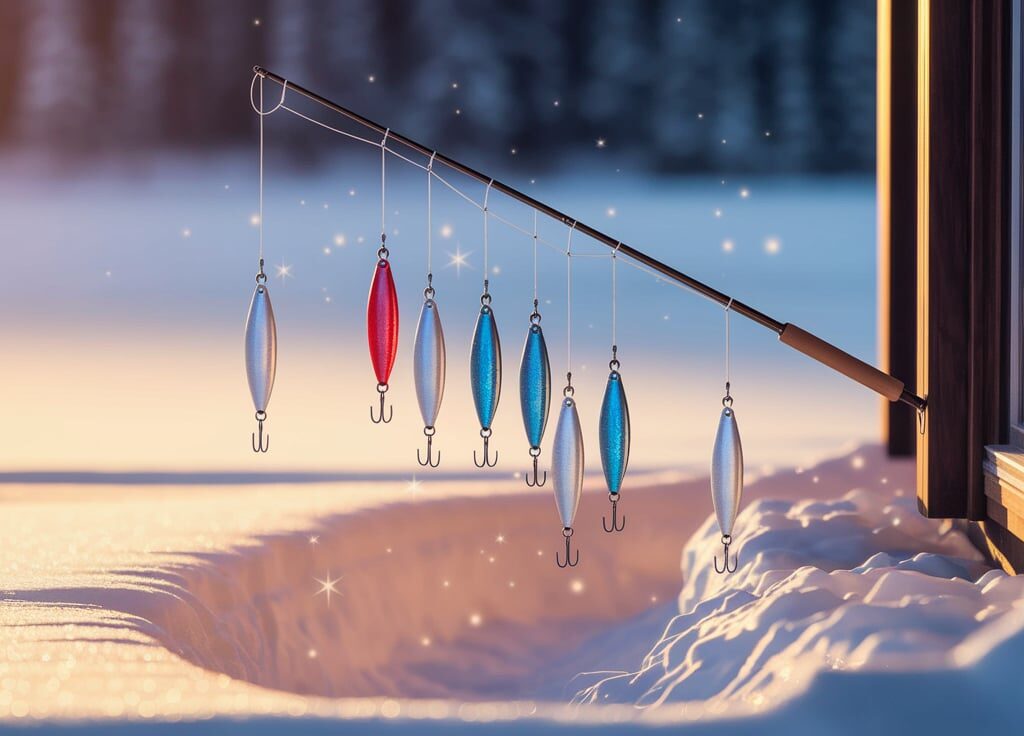Imagine standing on a frozen lake, feeling the crisp air on your cheeks, and knowing you have the perfect lure to catch the big one. Ice fishing isn’t just about patience; it’s about using the right tools, and there’s nothing more rewarding than using a lure you’ve crafted yourself.
You might think making your own ice fishing lures is complex, but it’s simpler than you imagine. By the end of this article, you’ll discover step-by-step how to create lures that are not only effective but also uniquely yours. Whether you’re a seasoned angler or a curious beginner, crafting your own lures can transform your fishing experience.
Ready to dive into the world of homemade ice fishing lures? Let’s get started!
Choosing The Right Materials
Making ice fishing lures requires choosing the right materials. The materials determine the lure’s effectiveness. Choose wisely for successful fishing trips. Understanding the components helps create appealing and functional lures.
Types Of Lure Bodies
Lure bodies come in various shapes and materials. Plastic and metal are common choices. Plastic bodies are lightweight. Metal bodies offer durability. Consider the water conditions. Clear water might need a shiny metal body. Murky water benefits from a bright plastic one.
Best Hooks For Ice Fishing
Hooks are crucial for catching fish. Choose hooks that match your target fish size. Small fish need smaller hooks. Larger hooks suit bigger fish. Stainless steel hooks resist rust. They are a popular choice for ice fishing. Check the sharpness regularly. A sharp hook increases your catch rate.
Essential Accessories
Accessories enhance your lure’s appeal. Feathers and beads add color and motion. They attract fish in murky waters. Glow paint can be useful. It helps in low-light conditions. Split rings attach hooks securely. Use pliers for easy attachment.
Crafting Techniques
Creating ice fishing lures involves shaping and painting small, metal or plastic pieces. Bright colors attract fish under icy waters. Adding hooks completes the lure for successful fishing trips.
Crafting your own ice fishing lures can be a rewarding experience. It allows for creativity and customization. Knowing the right techniques can make all the difference. Let’s explore some effective crafting methods.Shaping Lure Bodies
Start with basic materials like wood or plastic. Choose a material that is easy to carve. Use simple tools to shape the lure body. A knife or small saw works well. Aim for a streamlined shape. This helps it move attractively in the water. Sand the surface smooth. This removes any rough edges. A smooth lure glides better through the water.Painting And Finishing
Choose bright colors for visibility. Fish are attracted to vivid shades. Use waterproof paint for durability. Apply thin layers for an even coat. Let each layer dry completely. This prevents smudging. Add a clear sealant on top. This protects the paint from water damage. A shiny finish can mimic fish scales.Adding Attractive Features
Incorporate features that mimic real bait. Add small eyes or fins. Use glitter or reflective tape. This catches light underwater. Attach feathers or small rubber pieces. These add movement to the lure. Small rattles can also be effective. They create noise that attracts fish. Ensure all features are securely attached. This prevents loss during fishing trips.Customizing For Different Fish Species
Crafting ice fishing lures tailored to specific fish species boosts catch rates. Adjust colors and sizes for different preferences. Experiment with materials to mimic natural prey.
Customizing your ice fishing lures for different fish species can significantly boost your success on the ice. By tailoring your lures to match the preferences of specific species, you increase your chances of a fruitful catch. Whether you’re chasing the elusive trout, the mighty pike, or the plentiful panfish, a little customization can go a long way. ###Targeting Trout
Trout are often attracted to lures that mimic their natural prey. Small jigs in vibrant colors like orange, pink, or chartreuse can catch their attention. Try adding a bit of feather or fur to your lure for extra movement. Metallic spoons that flash in the water can also be effective. Adjusting the size and color of your lure can make a big difference. Have you ever noticed how trout seem to ignore your lure until you switch it up? The key is experimentation. Don’t be afraid to make quick adjustments if you’re not getting bites. What worked last season might not work today, so stay flexible and observant. ###Perfect Lures For Pike
Pike are aggressive predators and often go after larger lures. Consider using spoons or spinnerbaits with a bit of flash to provoke their curiosity. Adding a touch of red or a metallic finish can be especially enticing. Lures with a bit of bulk can mimic the prey pike are hunting under the ice. Using soft plastics that have a realistic shape and movement can be a game-changer. Have you tried adding a scent or flavor to your lure to make it even more tempting? Remember, pike are known for their fierce strikes. Make sure your gear is sturdy enough to handle their power. Experiment with different sizes and styles until you find what gets the best reaction. ###Best Options For Panfish
Panfish, including species like bluegill and crappie, are often drawn to smaller, subtle lures. Small jigs and micro spoons in natural colors work wonders. Try using a wax worm or a small piece of bait on the hook for added appeal. The movement is crucial when targeting panfish. A gentle jigging motion can mimic the small aquatic life they feed on. Have you ever thought about the impact of your jigging technique on your catch rate? Fishing for panfish can be a great opportunity to test out different lure designs. Keep your approach varied and watch how the fish respond. You’ll quickly learn what works best in different conditions. Customizing your lures for specific fish species is not just about increasing your catch. It’s about understanding the habits and preferences of the fish you’re after. What insights have you gained from your own lure experiments? Share your experiences and see what works for others too.Testing And Refining Lures
Creating your own ice fishing lures can be both a rewarding hobby and a practical way to enhance your fishing experience. However, once you’ve crafted your lures, the journey doesn’t end there. Testing and refining them is crucial to ensure they perform well in icy waters. This process involves trial and error, but with the right approach, you can transform a simple lure into a highly effective fishing tool. Let’s dive into the essential steps for testing and refining your ice fishing lures.
Field Testing Methods
Head out to your local frozen lake and put your lures to the test. Start by noting the weather conditions and ice thickness. These factors can affect how your lure behaves in the water.
Try different retrieval speeds and techniques. Observe how fish respond. Are they biting? Or are they ignoring your lure entirely? Keep notes on what works and what doesn’t.
Consider filming your tests. A short video can reveal subtle movements or flaws that may not be obvious at first glance. Would you have guessed that a slight tweak in technique could change everything?
Adjusting Weight And Balance
Does your lure sink too quickly or not enough? Adjust its weight by adding or removing components like lead strips or weights.
Balance is key. An unbalanced lure can look unnatural. Test its balance by observing its movement in the water. Does it wobble or stay steady?
Experiment with different configurations. Use small weights to make precise adjustments. Have you found the perfect balance yet?
Improving Lure Action
A lure’s action can make all the difference. Test its movement by slowly dragging it across the ice-covered water. Is it enticing enough?
If the action seems off, try modifying the lure’s shape or adding a tail. Sometimes a simple change can mimic the movements of natural prey.
Enhance the action with color or reflective surfaces. These can attract fish even from a distance. Could a splash of color be the secret to your success?
By focusing on these testing and refining techniques, you not only increase your chances of a successful catch but also gain valuable insights into lure-making. Each adjustment brings you closer to crafting the perfect ice fishing lure. Are you ready to test your creations and make your next fishing trip more fruitful?
Storage And Maintenance
Proper storage keeps ice fishing lures in top condition. Clean and dry them before storing in tackle boxes. Regular maintenance ensures their longevity and effectiveness on your next fishing trip.
Storing and maintaining your ice fishing lures properly is crucial to ensure they last longer and perform optimally. A well-cared-for lure not only saves you money but also increases your chances of a successful fishing trip. Let’s dive into how you can store and maintain your lures effectively to keep them in top shape.Safe Storage Solutions
Organizing your lures systematically can make your fishing trips more efficient and enjoyable. Use tackle boxes with adjustable compartments to keep your lures separated by type and size. This prevents tangling and damage. Consider using silica gel packs in your storage containers to absorb moisture. This helps to prevent rust and corrosion, keeping your lures in prime condition. A tip I learned after a damp fishing trip is to always dry your lures thoroughly before storing them. Have you thought about where you store your tackle box? Keep it in a cool, dry place to avoid extreme temperatures that could warp or damage your lures.Cleaning And Care Tips
Regular cleaning of your lures can prevent buildup of grime and fish residue, which can affect their effectiveness. Use warm soapy water and a soft brush to clean them gently. Be mindful of any intricate parts that might require extra attention. Dry your lures completely after cleaning to avoid rusting. A soft cloth works well for this purpose. It’s surprising how a little care goes a long way in maintaining the quality of your lures. Have you ever considered using a drop of oil on the hooks and joints? This small step can prevent rust and ensure smooth movement.Prolonging Lure Lifespan
Inspect your lures regularly for any signs of wear and tear. Replace rusty hooks and damaged parts immediately to keep them in top condition. This proactive approach can prevent losing a catch due to malfunctioning gear. Rotate your lures to ensure even wear. Using the same lure every time can cause it to degrade faster. Diversifying your choices not only prolongs the life of your lures but also keeps your fishing strategy fresh. What’s your go-to lure for ice fishing? Consider keeping a log of which lures work best for different conditions and species. This can help you make informed decisions and maintain your collection more effectively. By implementing these storage and maintenance strategies, you’ll extend the life of your ice fishing lures and enjoy more successful fishing adventures. With a little effort, you can keep your lures in peak condition season after season.Frequently Asked Questions
How To Make Homemade Fishing Baits?
Combine flour, cornmeal, and water to form dough. Add scents like garlic or vanilla for attraction. Shape into balls and refrigerate. Use worms, minnows, or insects for live bait. Homemade baits are cost-effective and customizable for better fishing results. Always ensure the bait matches the target fish species.
How To Make Ice Picks For Ice Fishing?
To make ice picks, attach metal spikes to wooden handles securely. Sharpen spikes for effective penetration. Use strong adhesive or screws to ensure stability. Consider adding wrist straps for safety. Test the picks on ice before using them for fishing.
Always prioritize safety when crafting and using homemade tools.
What Do You Use For Ice Fishing Lures?
Ice fishing lures often include jigs, spoons, and soft plastics. Choose bright colors for visibility. Opt for smaller sizes to mimic natural prey. Live bait like minnows or wax worms enhances attraction. Adjust lure type based on target fish species and water conditions.
Keep experimenting to find the best lure.
Can You Make Money Making Fishing Lures?
Yes, making fishing lures can be profitable. Create unique designs and sell them online or at local markets. Focus on quality and marketing to attract customers. Building a brand can increase income potential. Understanding your target audience is crucial for success in this niche.
Conclusion
Making your own ice fishing lures can be fun and rewarding. It allows you to customize colors and designs to suit your fishing style. Homemade lures often catch more fish because they’re unique. You don’t need many tools or materials to get started.
Just follow simple steps and practice patience. Soon, you’ll create lures that attract fish. Experiment with different shapes and sizes. This helps you learn what works best. Enjoy the process and share your creations with friends. Ice fishing becomes more exciting with lures you crafted yourself.
Happy fishing!



